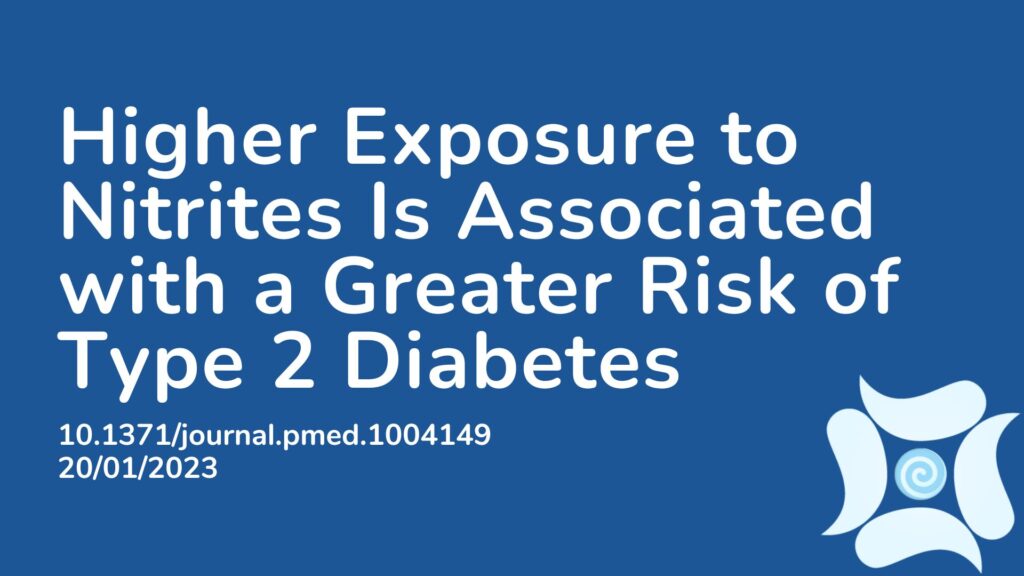Summary:
Nitrites and nitrates are common food additives found in processed meat, as well as compounds that naturally occur in soil and water. It is currently unclear whether they exhibit harmful or beneficial impacts for human health, specifically type 2 diabetes (T2D). The aim of this study was to examine the association between nitrates and nitrites and T2D in a large population study containing 104,168 adults who self-reported their intake from a large database of foods. There was no strong association between total intake (food and water/soil originated) and T2D risk however the authors were able to conclude that there is no potential benefits for dietary nitrites and nitrates. Although not significantly associated enough to suggest causation, the results did suggest that a higher exposure to both added and naturally occuring nitrites was associated with a higher risk of T2D.
Abstract:
Background: Nitrites and nitrates occur naturally in water and soil and are commonly ingested from drinking water and dietary sources. They are also used as food additives, mainly in processed meats, to increase shelf life and to avoid bacterial growth. Experimental studies suggested both benefits and harmful effects of nitrites and nitrates exposure on type 2 diabetes (T2D) onset, but epidemiological and clinical data are lacking. We aimed to study these associations in a large population-based prospective cohort study, distinguishing foods and water-originated nitrites/nitrates from those from food additives. Methods and findings: Overall, 104,168 adults from the French NutriNet-Santé cohort study (2009 to 2021, 79.1% female, mean age [SD] = 42.7 [14.5]) were included. Associations between self-reported exposure to nitrites and nitrates (evaluated using repeated 24-h dietary records, linked to a comprehensive food composition database and accounting for commercial names/brands details of industrial products) and risk of T2D were assessed using cause-specific multivariable Cox proportional hazard models adjusted for known risk factors (sociodemographic, anthropometric, lifestyle, medical history, and nutritional factors). During a median follow-up duration of 7.3 years (interquartile range: [3.2; 10.1] years), 969 incident T2D cases were ascertained. Total nitrites and foods and water-originated nitrites were both positively associated with a higher T2D risk (HRtertile 3 vs.1 = 1.27 (95% CI 1.04 to 1.54), Ptrend = 0.009 and 1.26 (95% CI 1.03 to 1.54), Ptrend = 0.02, respectively). Participants with higher exposure to additives-originated nitrites (i.e., above the sex-specific median) and specifically those having higher exposure to sodium nitrite (e250) had a higher T2D risk compared with those who were not exposed to additives-originated nitrites (HR higher consumers vs. non-consumers = 1.53 (95% CI 1.24 to 1.88), Ptrend < 0.001 and 1.54 (95% CI 1.26 to 1.90), Ptrend < 0.001, respectively). There was no evidence for an association between total, foods and water-originated, or additives-originated nitrates and T2D risk (all Ptrend = 0.7). No causal link can be established from this observational study. Main limitations include possible exposure measurement errors and the lack of validation versus specific nitrites/nitrates biomarkers; potential selection bias linked to the healthier behaviors of the cohort’s participants compared to the general population; potential residual confounding linked to the observational design, as well as a self-reported, yet cross-checked, case ascertainment. Conclusions: The findings of this large prospective cohort did not support any potential benefits for dietary nitrites and nitrates. They suggested that a higher exposure to both foods and water-originated and additives-originated nitrites was associated with higher T2D risk in the NutriNet-Santé cohort. This study provides a new piece of evidence in the context of current debates about updating regulations to limit the use of nitrites as food additives. The results need to be replicated in other populations.
Article Publication Date: 20/01/2023
DOI: 10.1371/journal.pmed.1004149




